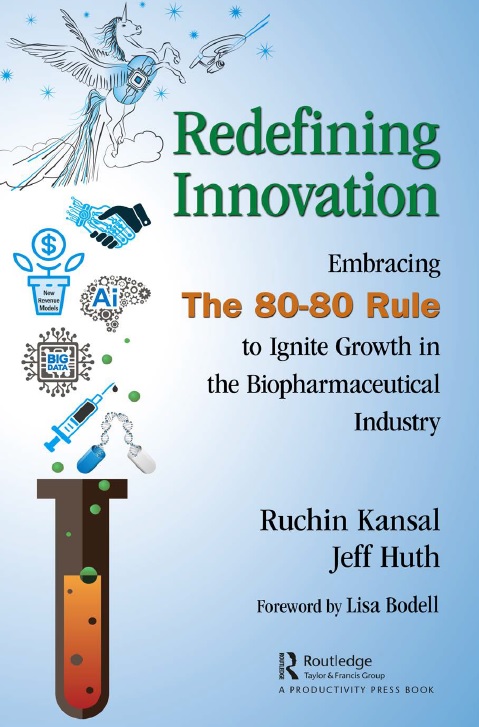by Jeff Huth and Ruchin Kansal

Contents
Setting the Context……………………………………………………xiii
Foreword……………………………………………………………………xv
Preface………………………………………………………………………xxi
Acknowledgments…………………………………………………..xxxi
The 80-80 Rule……………………………………………………….xxxv
I REDEFINING INNOVATION
1 Rise of a Unicorn Industry…………………………………3
Unintended Consequences of Disconnected Choices……..4
The Western Biopharmaceutical Industry Takes Shape…..6
The Golden Era………………………………………………………….12
A “Unicorn Industry” Is in Place………………………………….19
A Perspective on Global Differences in Reimbursement of Biopharmaceuticals………25
Endnotes……………………………………………………………………26
2 The Unicorn Industry Loses Its Wings……………….29
Limited White Spaces for Traditional Product-Focused Innovation…………………………………………………………………34
Therapies versus Cures……………………………………………….35
Outcome and Value versus Safety and Efficacy……………..36
Transition from Old to New Technology………………………37
Commoditization………………………………………………………..39
Consumerism…………………………………………………………….42
New Disruptors…………………………………………………………44
Evolution of the Regulatory Framework as a Source of Disruption…………………………………………………………….46
An Industry Perspective………………………………………………51
The Future?………………………………………………………………..54
Endnotes……………………………………………………………………57
3 An Experiment in Challenging the Status Quo……59
Challenging the Status Quo…………………………………………60
Innovation Is Not a Choice………………………………………….63
Endnotes……………………………………………………………………67
4 Innovation Redefined………………………………………69
Redefining Innovation………………………………………………..72
Drive the Core, but Know It Is a Short-Term Game……….76
Invest in Adjacent; It Is Easier to Execute……………………..81
Experiment with Breakthrough to Define New Futures…………………………………………………………………94
Beyond Healthcare…………………………………………………….96
Endnotes…………………………………………………………………..98
5 Next-Generation Unicorn Industry…………………..101
Endnotes………………………………………………………………….109
II IGNITING GROWTH
6 Applying “The 80-80 Rule”…………………………….113
7 Setting Up for Success……………………………………117
Leadership Foresight and Courage to Invest………………..117
A New Breed of Leaders……………………………………………120
Teaming the Right Talent…………………………………………..124
Reflections on the Experiment in Challenging the Status Quo……………………………………………………………….131
Endnote…………………………………………………………………..132
8 Finding White Spaces…………………………………….133
Embrace the Need, Money Will Follow………………………135
Outside In First, Inside Out Next……………………………….140
Endnotes………………………………………………………………….145
9 Developing New Ventures……………………………….147
Design for the End User, but Consider the Ecosystem….149
Keep It Modular……………………………………………………….150
Keep It Simple………………………………………………………….151
10 Becoming Adept at Partnering………………………..159
Partnerships That Span Development and Commercialization……………………………………………………163
Making Partnerships Work………………………………………..166
11 Afterword…………………………………………………….169
Authors………………………………………………………………177
Index 181
The 80-80 Rule
It is a pretty safe bet that all of our readers are familiar with the Pareto principle (also known as the 80/20 rule), which states that, for many events, roughly 80% of the effects come from 20% of the causes. We would like to introduce the 80-80 Rule governing how to adjust thinking and behavior when the urgency to innovate is evident: “Being 80% confident that you will only be 80% right the first time should feel normal.” The 80-80 Rule should not be interpreted as a statistical methodology for predicting success in business endeavors; instead, it is intended to reflect a required philosophical shift toward challenging the status quo in just about every aspect of business innovation.
In our view, the one quality that makes innovators successful is that they resist the temptation of always trying to be 100% right every time. Instead, they have an overarching vision, and they are not afraid to make mistakes along the way toward achieving that vision.
In corporate environments, especially where the incumbent has been successful and an industry leader for long periods of time, the focus becomes building a replicable machine that runs the core business over and over again efficiently. Risk taking is minimized and replaced by standard operating procedures, efficiency overrules experimentation, pre-defined metrics drive performance, and incentives are tied to current financial returns. The spirit of innovation, taking risks, experimenting—the very characteristics that made the incumbent successful in the first place—are often lost.
Continuing to think beyond the status quo of the core business to transform or disrupt it requires a mindful culture, and a deliberate focus and effort. It should allow individuals within organizations to realize how existing strengths can be applied to discover new paths and businesses of the future. Intentional innovation, understanding that fast failure coupled with objective review can itself be a relevant metric, and being 80% confident that initially any solution will only be 80% right is a good thing. The biopharmaceutical industry is very comfortable with the risk and failure rate inherent in the discovery and development of its current products. However, it struggles to adopt a similar risk-based philosophy when thinking about a broader definition of innovation which we believe is essential for long-term viability. The 80-80 Rule intends to rekindle that spirit of innovation by making the discomfort and conflict that comes with challenging the status quo feel normal again.
We are, however, not advocating that risk taking or experimentation should be an unstructured exercise. If you are 100% confident that every experiment undertaken will yield positive results, you are not being pragmatic and looking for blind-spots. This attitude borders on arrogance. At the same time, if you wait to be 100% certain before moving to the next step, it probably means that someone else may have already capitalized on your idea because you spent too much time in the quest for perfection. Also know that if you are 100% right the first time, it is pure chance, not an act of genius.
The 80-80 Rule means having the courage to explore unknown paths, recognizing that there will be failure along the way. It is only through exploration and experimentation that the new is discovered, that innovation becomes real. In this book, we examine how the 80-80 Rule can create the shift so urgently needed by the biopharmaceutical industry to find its way back to its former glory.
